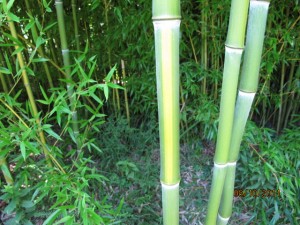Bamboo is NOT considered an invasive plant in Connecticut.
However, there have been many questions about bamboo control and bamboo laws from

homeowners and gardeners. Please see the information below for more information about bamboo.
Note that due to legal changes, some items may no longer be accurate.
1. Bamboo FAQ’s:
This Document provides answers to some of the more frequently asked questions about the bamboo laws.
2. History of bamboo issue in CT:
The CT Invasive Plants Council (IPC) submitted testimony in support of the first bamboo bill (S.B. 1016) prior to its passage. The testimony provides a good summary of the bamboo issue in Connecticut, as well as information about why bamboo is not considered invasive in the state. View the testimony about bamboo here.
The IPC continues to monitor bamboo in Connecticut. For more information on the Council, visit the IPC page.
3. Legal information:
CGS 22a-381e. Prohibited actions re running bamboo. Disclosure statement. Penalties. Enforcement.
(a) For the purpose of this section, “running bamboo” means any bamboo in the genus Phyllostachys, including Phyllostachys aureosulcata.
(b) No person who plants running bamboo or who allows running bamboo to be planted on his or her property shall permit such bamboo to grow beyond the boundaries of his or her property. On and after October 1, 2013, any person who violates the provisions of this subsection shall be liable for any damages caused to any neighboring property by such bamboo, including, but not limited to, the cost of removal of any running bamboo that grew beyond the boundaries of his or her property.
(c) No person shall plant running bamboo or allow running bamboo to be planted on his or her property at a location that is forty feet or less from any abutting property or public right-of-way. Any person who violates the provisions of this subsection shall be fined one hundred dollars. In the case of a continuing violation, each day of continuance shall be deemed a separate and distinct offense until such time as such bamboo is removed or contained by a properly installed and constructed barrier system.
(d) Each retail seller or installer of running bamboo shall provide to each customer who purchases running bamboo from such seller or installer a statement that discloses that running bamboo is a fast growing plant that may spread if not properly contained and a plain language summary of the provisions contained in subsections (b) and (c) of this section. Such statement shall also provide recommendations, based on best available information, on how to properly contain running bamboo. Any retail seller or installer of running bamboo who violates the provisions of this subsection shall be fined one hundred dollars for each plant sold in violation of this section.
(e) The Department of Energy and Environmental Protection, any duly authorized municipal constable, municipal tree warden, zoning enforcement officer or inland wetlands and watercourses enforcement officer may enforce the provisions of subsections (c) and (d) of this section.
| Subsection 7 – C Revised | Sec. 7. Subsection (c) of section 22a-381e of the general statutes is repealed and the following is substituted in lieu thereof (Effective from passage):
(c) No person shall plant running bamboo or allow running bamboo to be planted on his or her property at a location that is forty feet or less from any abutting property or public right-of-way. Any person who violates the provisions of this subsection shall be fined one hundred dollars. In the case of a continuing violation, each day of continuance shall be deemed a separate and distinct offense until such time as such bamboo is removed. [or contained by a properly installed and constructed barrier system. ] |
2016 | View CGS here |
| Public Act No. 16-89 | AN ACT CONCERNING THE SITING OF CERTAIN DOCKS AND STRUCTURES, THE USE OF NOISE-MAKING DEVICES FOR AGRICULTURAL PURPOSES AND MAKING TECHNICAL AND CONFORMING REVISIONS TO ENVIRONMENT-RELATED STATUTES. | Passed 2016 | View CGS here |
| Public Act 13-82 | AN ACT REGULATING THE PLANTING AND SALE OF RUNNING BAMBOO | Passed 6/5/13 | View PDF of text here |
| CGS Sec. 22a-381e | Prohibited actions re running bamboo. Disclosure statement. Penalties. Enforcement | PA 13-82 was put into action through 22a-381e of the 2014 Supplement to the General Statutes | View CGS Sec. 22a-381e here |
| Public Act 14-100 | AN ACT CONCERNING LIABILITY FOR THE GROWING OF RUNNING BAMBOO | Changes were made to CGS Sec. 22a–381e when PA 14-100 was passed on 6/6/14 | View PDF of text here |
| Raised House Bill 6032 | AN ACT CLARIFYING PROVISIONS OF THE GENERAL STATUTES CONCERNING THE USE OF BARRIER SYSTEMS FOR CERTAIN PLANTINGS | A public hearing was held on 2/4/15 | View text of the raised bill and testimony here |
4. Bamboo identification:
The DEEP and UConn “Quick Guide to the Identification of Phyllostachys” illustrates which species are covered by the new laws. A PDF is available here.
5. Containment:
The CNLA and DEEP document outlining recommended containment instructions and the information requirement for growers is available here. These instructions may be updated as new research and information become available. NOTE: The information provided here may no longer be accurate.
6. Bamboo control:
This Clemson University document provides detailed information about control using mowing and/or a glyphosate-based herbicide. Always follow all label directions and all laws and ordinances when applying herbicides. View the website here or PDF here.
This Connecticut Agricultural Experiment Station document provides information on the background of bamboo in Connecticut, control recommendations based on their current research, and legal information. View the PDF here.
7. Disposal:
Running bamboo can spread by small fragments. For a complete list of disposal options for plant material, click here and follow the guidelines for herbaceous plants. Note that running bamboo, like Japanese knotweed, should not be composted or put in brush piles.